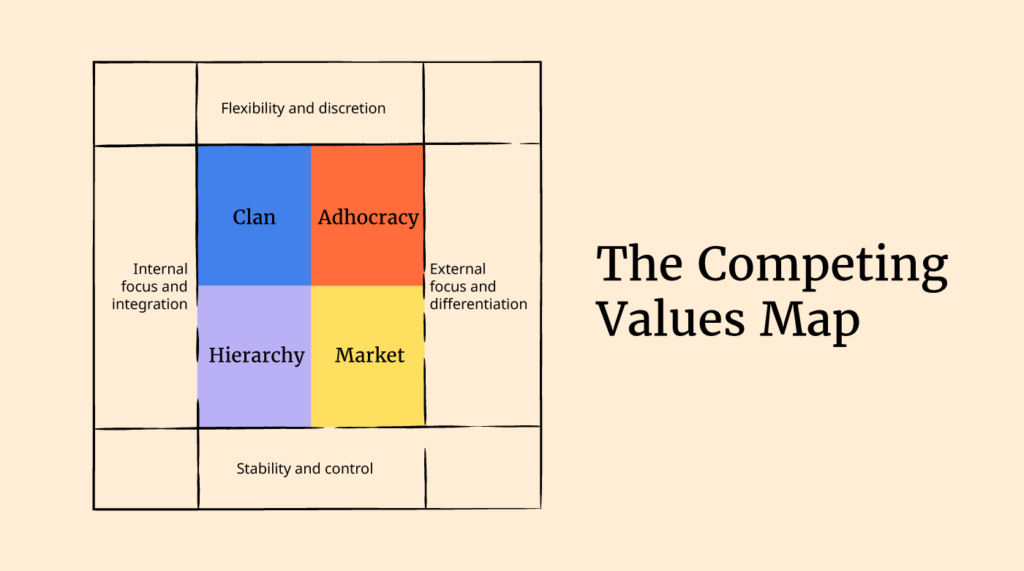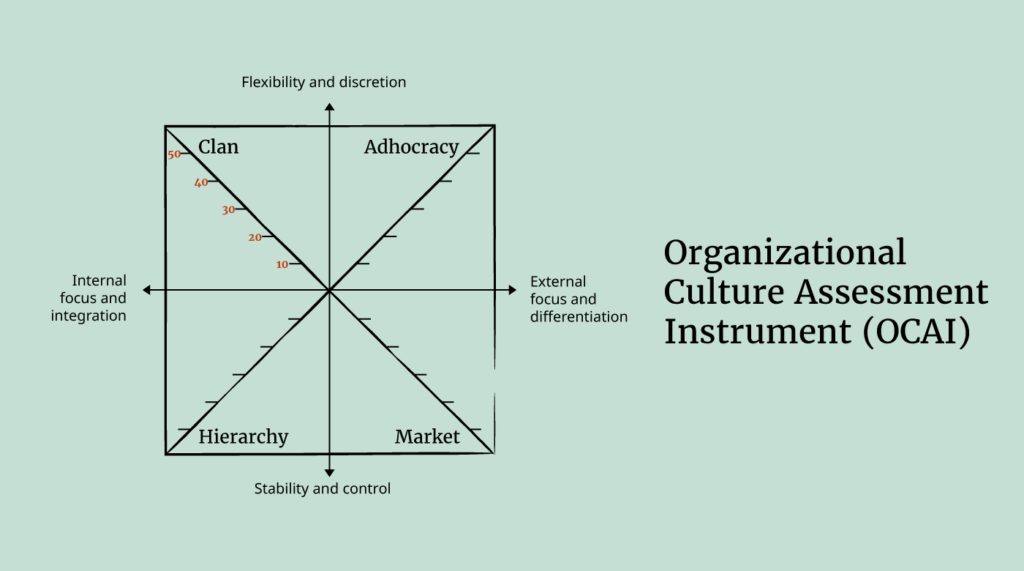Company culture is the way of life in an organization, encompassing core values, norms, and behaviors. It’s your special sauce that makes your company unique and distinguishes you from others.
Culture is a key factor in an organization’s success as it determines how strategy gets implemented. It also affects how an organization interacts with its customers, suppliers, government, and society.
No two organizations are the same, but they do share common characteristics and this includes cultural elements too.
Here I'll delve into 4 common company culture types and how you can determine yours.
Types Of Company Culture
If you can define your organization's culture, you can adapt and strengthen it.
The Competing Values Framework is a cultural assessment tool designed to help organizations understand and adapt their culture.
It breaks down culture into 4 types:
1. Hierarchy culture
A hierarchical company culture is built on structure and control from the top down, with a lot of respect for position and power.
This is the traditional bureaucratic type of company culture and—many startups would argue—an outmoded one.
The traditional bureaucratic type of company culture and—many startups would argue—an outmoded one. Hierarchical cultures are built on structure and control from the top down with a lot of respect for position and power.
Often, there are several layers of management between upper management and employees so this type of culture is common in large corporates and the military.
The emphasis is very much on “doing things right” and the smooth running of operations.
Pros: Well-defined processes, policies, and procedures; no issues with authority; clear role and responsibilities; clear paths for advancement.
Cons: Power is centralized at the top meaning potentially slower decision-making. Departments are siloed which may result in less collaboration between departments and flexibility overall.
2. Clan culture
A clan company culture is characterized by a family-like environment. This emphasizes collaboration, teamwork, and strong internal relationships with a high level of employee involvement and commitment.
Clan culture denotes a flat organizational structure and less onus on hierarchy.
The Clan or “Family” culture eschews the rigidity of Hierarchy cultures for a more flexible approach based on strong working relationships between team members.
Common amongst SMEs, employees tend to be loyal to the organization’s mission and values and each other, with a high degree of trust awarded to individuals and teams to complete tasks their way.
Pros: Flexibility—employees are driven and engaged to work for the organization and each other; a lot of investment in people’s development and mentoring.
Cons: Easier for employees and teams to go off-track; over-concern for group harmony and cohesion leading to group-think; potential lack of response to customer needs over organizational; cliquiness.
3. Adhocracy culture
An adhocracy culture is characterized by flexibility, innovation, and risk-taking. Creativity and individual initiative are highly valued, and processes and hierarchies are often less formalized.
These cultures provide even greater flexibility than Clan cultures, with teams rapidly forming to face new challenges based on market demands. The organizational structure may quickly change as projects are completed and new ones spring up.
As you’d imagine, these are fast-paced, some would say frenetic, places to work. Initiative and risk-taking are encouraged with limited managerial oversight.
Pros: Flexibility and innovation.
Cons: Without clearly defined responsibilities important tasks may be overlooked; lack of structure means it can be difficult for some people to adapt.
4. Market culture
A market culture is characterized by a strong focus on competition, results, and achievement. Success is measured by market share and penetration, emphasizing goals, outcomes, and productivity.
A reflection of the market itself, these are results-driven and performance-orientated. Goals are deliberately difficult to stretch employees and teams.
The focus is on maximizing profits with as little transaction cost between individuals and teams as possible (meaning unnecessary activity).
As you can imagine, these kinds of organizations are often highly competitive internally and aggressive externally.
Pros: Efficient, focus on customers, beating the market, and staying ahead; drive and ambition from employees.
Cons: Employee burnout, too much competition leading to dishonesty and conflict, lack of investment in employees.
Use the below diagram to get a feel for each culture type’s characteristics and how they overlap.

Assessing Your Culture
Now you’re aware of the company culture types laid out in the Competing Values Framework, you can use the Organization Culture Assessment Instrument (OCAI) to determine yours (although you probably have a strong gut feeling already!).
As you can see, the questionnaire has six categories. In each category:
Type A style indicates a Clan culture
Type B style indicates an Adhocracy culture
Type C style indicates a Market culture
Type D style indicates a Hierarchy culture
Work down the questions and distribute 100 points between the four sub-items. Add them up at the end to give you a dominant cultural archetype which you can plot on a graph.
This is often done twice: once for 'now' and once for 'preferred'.
| Category | Style |
|---|---|
| 1. Dominant organizational characteristics | A: Personal, like a family B: Entrepreneurial, risk-taking C: Competitive, achievement-oriented D: Controlled and structured |
| 2. Leadership style | A: Mentoring, facilitating, nurturing B: Entrepreneurial, innovative, risk taking C: No-nonsense, aggressive, results oriented D: Coordinating, organizing, efficiency-oriented |
| 3. Management of employees | A: Teamwork, consensus, and participation B: Individual risk-taking, innovation, freedom, and uniqueness C: Competitiveness and achievement D: Security, conformity, predictability |
| 4. Organizational glue | A: Loyalty and mutual trust B: Commitment to innovation, development C: Emphasis on achievement and goal accomplishment D: Formal rules and policies |
| 5. Strategic emphasis | A: Human development, high trust, openness B: Acquisition of resources, creating new challenges C: Competitive actions and winning D: Permanence and stability |
| 6. Criteria for success | A: Development of human resources, teamwork, concern for people B: Unique and new products and services C: Winning in the marketplace, outpacing the competition D: Dependable, efficient, low cost |

Nurturing Your Culture
The above framework can be useful to identify any aspects of your culture that are undesirable so you can adjust accordingly.
The framework is descriptive, there is no “best” type, and elements of each may be more prevalent and work best in different business areas.
To help nurture the culture you want, check out these articles on improving company culture and creating a high-performance culture.
You can also seek advice in the People Managing People Community, a supportive community of HR and business leaders sharing knowledge to help you progress in your career and make greater impact in your organization.


